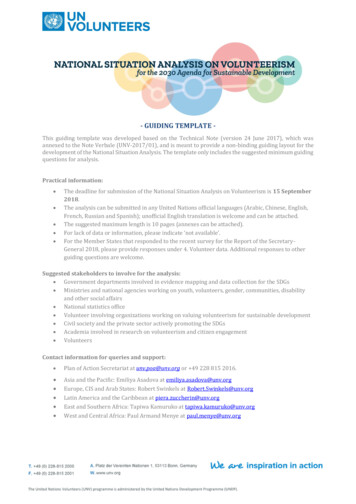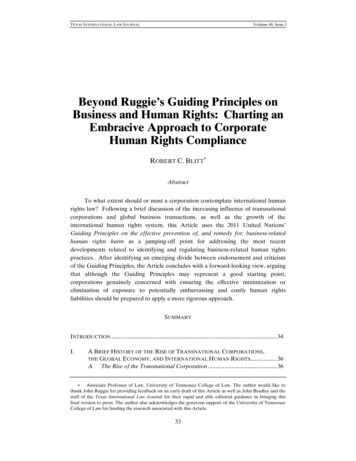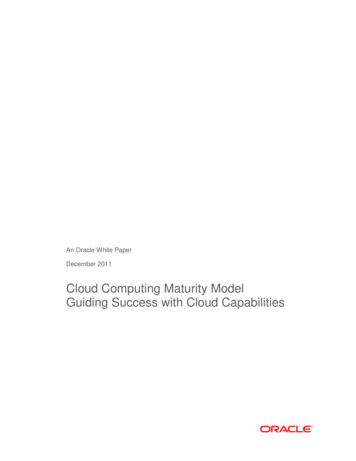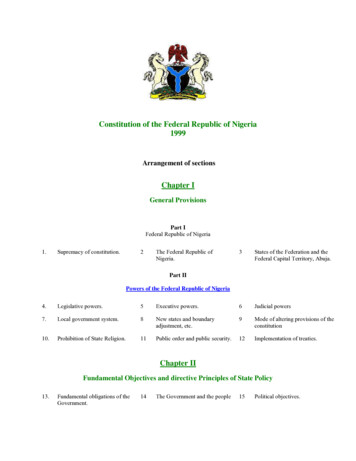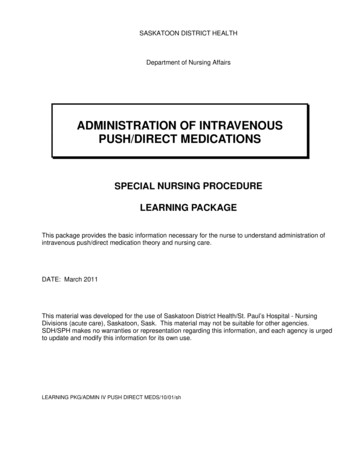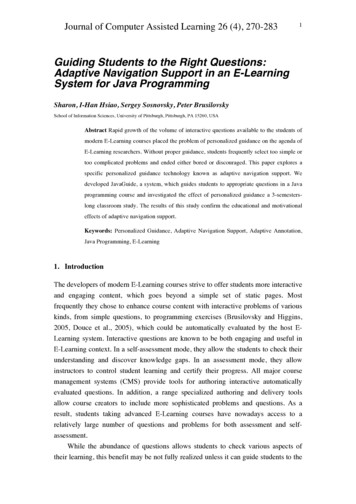
Transcription
Journal of Computer Assisted Learning 26 (4), 270-2831Guiding Students to the Right Questions:Adaptive Navigation Support in an E-LearningSystem for Java ProgrammingSharon, I-Han Hsiao, Sergey Sosnovsky, Peter BrusilovskySchool of Information Sciences, University of Pittsburgh, Pittsburgh, PA 15260, USAAbstract Rapid growth of the volume of interactive questions available to the students ofmodern E-Learning courses placed the problem of personalized guidance on the agenda ofE-Learning researchers. Without proper guidance, students frequently select too simple ortoo complicated problems and ended either bored or discouraged. This paper explores aspecific personalized guidance technology known as adaptive navigation support. Wedeveloped JavaGuide, a system, which guides students to appropriate questions in a Javaprogramming course and investigated the effect of personalized guidance a 3-semesterslong classroom study. The results of this study confirm the educational and motivationaleffects of adaptive navigation support.Keywords: Personalized Guidance, Adaptive Navigation Support, Adaptive Annotation,Java Programming, E-Learning1. IntroductionThe developers of modern E-Learning courses strive to offer students more interactiveand engaging content, which goes beyond a simple set of static pages. Mostfrequently they chose to enhance course content with interactive problems of variouskinds, from simple questions, to programming exercises (Brusilovsky and Higgins,2005, Douce et al., 2005), which could be automatically evaluated by the host ELearning system. Interactive questions are known to be both engaging and useful inE-Learning context. In a self-assessment mode, they allow the students to check theirunderstanding and discover knowledge gaps. In an assessment mode, they allowinstructors to control student learning and certify their progress. All major coursemanagement systems (CMS) provide tools for authoring interactive automaticallyevaluated questions. In addition, a range specialized authoring and delivery toolsallow course creators to include more sophisticated problems and questions. As aresult, students taking advanced E-Learning courses have nowadays access to arelatively large number of questions and problems for both assessment and selfassessment.While the abundance of questions allows students to check various aspects oftheir learning, this benefit may be not fully realized unless it can guide students to the
Journal of Computer Assisted Learning 26 (4), 270-2832right questions at the right time as a skillful human tutor does. Without properguidance, students frequently select too simple or too complicated problems and, as aresult, become either bored or discouraged. Unfortunately, “one-size-fits-all”solutions of this guidance problem (such as, ordering questions in a fixed sequence)do not work since students typically have different starting knowledge and learn atdifferent paces. To remedy this problem, an adaptive guidance should be providedaccording to the current state of student’s knowledge. The two most popular methodsof personalized guidance are adaptive problem generation (Kumar, 2005b, Koffmanand Perry, 1976, Fischer and Steinmetz, 2000, Myller, 2006) and adaptive problemselection (Mayo and Mitrovich, 2000, Mitrovic and Martin, 2004, Kumar, 2006,Ullrich et al., 2009). They allow students to focus on problems of optimal difficulty.The negative side of both these approaches is their restrictive nature: they make theadaptive choice for the students leaving them no freedom over the selection process.A potential side effect of such strategy is student’s inability to alter an improperproblem selection, which may happen if the student model has been incorrect. In ourpast work (Brusilovsky and Pesin, 1994, Brusilovsky and Sosnovsky, 2005a), weexplored a less restrictive strategy of adaptive guidance – adaptive navigation supportfor selecting questions. Adaptive navigation support guides the students to the mostappropriate questions by changing the appearance of links to the questions. Thisapproach relies on the synergy between the artificial intelligence (AI) of the systemand the students’ own intelligence and often brings better results and highersatisfaction. The evaluation of personalized guidance in self-assessment context(Brusilovsky and Pesin, 1994, Brusilovsky and Sosnovsky, 2005a) demonstrated thatthis technology indeed, helps the students to get to the right question at the right timesignificantly increasing their chance to answer the question correctly. Moreover, wealso discovered that the provision of adaptive navigation support dramaticallyincreases the percentage of students actively using educational software, the amountof their work, and frequency of using the system (Brusilovsky et al., 2006).While our past research demonstrated several benefits of using adaptivenavigation support for guiding students to the right questions, a number of questionsstayed unanswered. First, the quiz questions used in our studies were relatively simple.As a result, it was left unclear whether the benefits of adaptive navigation support arerestricted to simple questions or this technology can successfully guide students to abroader range of questions: from relatively simple to very difficult. Second, due to arelatively small number of subjects in our classroom studies, we were not able toseparately assess the impact of adaptive navigation support technology on strongerand weaker students, which is a typical research question in the area of AI inEducation (Mitrovic, 2007). It is known that some educational innovations may be
Journal of Computer Assisted Learning 26 (4), 270-2833especially beneficial for stronger or weaker students, while others provide equalsupport to both groups, but earlier research has not explored this aspect of adaptivenavigation support technology.The work presented in this paper attempted to investigate adaptive navigationsupport for self-assessment questions beyond the original narrow scope, i.e., in largerclasses and with a broader range of question difficulty. To allow this expansion, wemoved our studies to a new and more sophisticated domain of Java programminglanguage, which is now the language of choice in most introductory programmingclasses. To form the basis for our study, we developed QuizJET (Java EvaluationToolkit), a system for authoring, delivery, and evaluation of parameterized questionsfor Java (Hsiao, 2008). A preliminary evaluation has demonstrated that QuizJETs’questions are educationally beneficial: we found a significant relationship between thequality and the amount of work done by students in QuizJET and their performance.By using the system, students were able to improve their in-class weekly quiz scores.We also found that their success in QuizJET (percentage of correct answers)positively correlates with scores on the final exam.Once the effect of QuizJET questions was confirmed, we developed JavaGuidesystem, which uses adaptive navigation support to guides students to most appropriateQuizJET questions. The effect of adaptive navigation support was evaluated in a 3semesters-long classroom study, which specifically attempted to assess the impact ofadaptive navigation support to student work with questions of different complexity aswell as the impact of this technology on weaker and stronger students.The rest of the paper presents our account of this work. After a brief overview ofrelated work, we present the details of both: QuizJET’s and JavaGuide’simplementation, explain the nature of adaptive navigation support, and report theresults of classroom studies. We conclude with the summary of results and a briefdiscussion.2. Related Work2.1 Parameterized Questions in E-LearningParameterized questions and exercises emerged as an active research area in the fieldof E-Learning (Brusilovsky, 2005). This technology allows obtaining many objectivequestions from a relatively small number of templates created by content authors.Using randomly generated parameters, every question template is able to producemany similar, yet sufficiently different questions. As demonstrated by a number ofprojects such as CAPA (Kashy, 1997), WebAssign (Titus, 1998), EEAP282 (Merat,1997), Mallard (Graham, 1997), and COMBA (Sitthisak, 2008), parameterized
Journal of Computer Assisted Learning 26 (4), 270-2834questions can be used effectively in a number of domains allowing to increase thenumber of assessment items, decrease authoring efforts, and reduce cheating. Whileparameterized questions were mostly used in “formula-based” problems, we can namea few projects that applied parameterized question generation in E-Learning systemsfor programming domain (Krishna and Kumar, 2001, Kumar, 2005a, Kumar, 2000,Koffman and Perry, 1976, Martin and Mitrovic, 2002). In the context of other workon parameterized question generation, our approach could be considered relativelysimple and straightforward. Our goal was not to improve problem generation, but toimplement a practical and robust solution that can dramatically reduce authoringeffort required to create a sizeable collection of questions for teaching programming.2.2 Adaptive Navigation Support in E-LearningAdaptive navigation support is a group of techniques that aim to help individual userslocate, relevant information in the context of hypertext and hypermedia (Brusilovsky,2001). By adaptively altering the appearance of links on every browsed page, suchmethods as direct guidance, adaptive ordering, adaptive link hiding and removal, andadaptive link annotation support browsing-based personalized access to information.E-Learning, with its constant need to adapt to the level of student knowledge, is oneof the most active application areas of adaptive navigation support. In E-Learningcontext, these techniques demonstrated their ability to support faster achievement ofthe users’ goals, reduce navigational overhead, and increase user satisfaction (Olstonand Chi, 2003, Kavcic, 2004, Davidovic et al., 2003, Brusilovsky and Eklund, 1998).However, the majority of systems applying these techniques in E-Learning, as well asthe majority of evaluation studies, focused only on guiding students to the right pieceof text-based content – such as concept introduction or explanation. In this context,neither the complexity of the content, nor the student learning success can bemeasured reliably. In contrast, our work presents one of the very few examples ofapplying adaptive navigation support to guide students to the most appropriatequestions and problems. We believe that such context offers a chance to increase theimpact of adaptive navigation support and allows better evaluation of this impact.3. QuizJET: Parameterized Questions for JavaQuizJET system has been designed to support Web-based authoring, delivery andevaluation of parameterized questions for Java programming language. QuizJET canbe used for assessment and self-assessment of students’ knowledge of broad range ofJava topics from language basics to advanced concepts, such as polymorphism,inheritance, and exceptions.
Journal of Computer Assisted Learning 26 (4), 270-2835In a taxonomy of task types in computing, questions generated by QuizJET belongto the group of prediction tasks (Bower, 2008). These tasks are becoming increasinglypopular in various computing-related courses (Myller, 2006, Malmi et al., 2005,Kumar, 2005a). To a large extent, the nature of tasks generated by QuizJET followsthe approach explored earlier in QuizPACK (Brusilovsky and Sosnovsky, 2005b).However, the switch of the domain from C to Java allowed QuizJET to generatequestions of much larger complexity, which was essential for our study.Table 1 presents the comparison of QuizPACK and QuizJET sets of questionsdeveloped to cover the introductory programming courses on C and Javacorrespondingly. The question complexity is measured by the number of conceptsinvolved in the question. For C, this number ranges from 1 to 19; for Java, it isbetween 4 and 297. As the table shows, the complexity range for C programmingquestions is relatively small with most questions falling to the easy group. On thecontrary, Java covers a wider spectrum of complexity with a wider questiondistribution among levels.Table 1. Programming language C & Java question complexityComplexity LevelEasyModerate1Moderate2ComplexLanguage# of concepts1 1516 4041 9091 287CJava1611900412021193.1 QuizJET Student InterfaceA typical QuizJET question consists of a small Java program. One (or several)numeric value in the text of the program is instantiated with a random parameterwhen the question is delivered to a student. As a result, student can access the samequestion multiple times with different values of the parameter and different correctanswers. To answer a question, students need to examine the program code and solvea follow-up task. The task can take one of two forms: “What will be the final value ofan indicated variable?” or “What will be printed by the program to the standardoutput?”A tabbed interface design has been implemented to allow questions consist ofseveral classes. The driver class, containing the main function, is always presented onthe first tab. It is the entry point to the question. The first tab also includes thequestion task and the field for student’s input. The system’s feedback is alsopresented in the first tab after a student’s answer has been evaluated. A QuizJETquestion example is presented in Figure 1. By clicking on different tabs students canswitch between the classes to access the full code of the program.
Journal of Computer Assisted Learning 26 (4), 270-2836Fig 1. The presentation of a QuizJET questionOnce a student enters an answer and clicks the “Submit” button, QuizJET reportsthe evaluation results and the correct answer (Figure 2). Whether the result werecorrect or not, the student can click the “Try Again” button to assess the samequestion with a different value of the generated parameters. This option providesstudents with an opportunity to master a particular topic.Fig 2: The evaluation results of a QuizJET question
Journal of Computer Assisted Learning 26 (4), 270-28373.2 QuizJET ArchitectureQuizJET has been developed as a component of ADAPT2 architecture for distributedadaptation and user modeling1. It complies with the ADAPT2 protocols for userauthentication, reporting user interaction, and adaptation. URLs of QuizJET questionscan be augmented with ADAPT2 HTTP parameters to notify the system about thecurrent user, group, and session. Upon verifying student answers QuizJET alsogenerates a learning event transaction, which contains information about the user, thequestion, the result of the interaction, etc. The transaction is sent to the user modelingserver CUMULATE that computes student knowledge and reports it to the interestedsystems (Brusilovsky et al., 2005). This architecture enables easy integration ofQuizJET with value-added adaptation services.Each QuizJET question is accessible by a unique URL. Once a question islaunched, QuizJET server generates a question and delivers it to a student’s browser.When the student submits a solution, QuizJET executes the question code to producethe right answer, compares it to the user’s input and presents a feedback.3.3 QuizJET Question AuthoringQuizJET offers a form-based online authoring interface for developing new quizzesand questions. Figure 3 demonstrates the process of QuizJET question authoring. Thequestion template form requires an author to specify several question parameters. Anauthor has to provide the Title for the question template and specify which Quiz itbelongs to. The rdfID is a unique attribute to reference the question template. A shortcomment about the question template can be given under the Description field. TheAssessment Type dropdown box is the attribute, which specifies the task of thequestion. Currently, there are two forms of the task available: evaluation of the finalvalue of a variable and prediction of what will be printed to the standard output. Thebody of the question template should be provided in the Code field. In the code, theParam variable indicates where the randomized parameter will be substituted.Maximum and Minimum specify the interval for the parameter generation. AnswerType dropdown box provides a list of data types for the final value. Privacy indicatesthe availability of the question to QuizJET users. Currently QuizJET includes 101question templates grouped into 21 quizzes. Authors are allowed to uploadsupplemental classes to include in their questions. Every supplemental class isreusable and is listed on the right hand side of the authoring interface (Figure 3).1Description of ADAPT2 can be found at: http://adapt2.sis.pitt.edu/wiki/ADAPT2
Journal of Computer Assisted Learning 26 (4), 270-2838the unique id toreference back to thisquestion templateParam indicatesthe randomizedparameterFig 3. A fully authored QuizJET parameterized question4. JavaGuide: Adaptive Navigation Support for QuizJET QuestionsThe development of QuizJET along with its authoring system, allowed us to create asufficient volume of questions, which was vital for further experiments withpersonalized guidance. Our next step was to develop JavaGuide, the system thatprovides students with personalized guidance to QuizJET questions. The questions inJavaGuide are combined under large topics (from three to six questions per topic) thatorganize the course material into instructionally complete chunks. Students canbrowse the material by clicking on topic and question links (Figure 4). A click on atopic link folds/unfolds questions available for the topic. This allows students toorganize their learning space more flexibly. A click on a question link loads thecorresponding question in the question frame of the system’s interface. On both levels– topics and questions – the system offers personalized guidance using adaptive linkannotation, one of the most popular adaptive navigation support techniques.
Journal of Computer Assisted Learning 26 (4), 270-2839Fig 4. JavaGuide InterfaceOn the topic level, JavaGuide uses a specific form of adaptive link annotation inspiredby the ideas of open learner modeling: it presents to a student the content of her/hisuser model in the form of navigational cues. Every topic link annotation representsthe current state of a student’s knowledge for the topic. As a result, a student isconstantly aware of his/her performance and is able to focus on those parts of thecourse, in which he/she has not demonstrated enough progress.Topic-level adaptive annotations are visible to students as “target-arrow” icons(Fig. 5). The icons deliver two kinds of information to the student: the individualperformance of the student with the topic’s content and the relevance of the topic tothe current learning goal of the entire course. The number of arrows (from 0 to 3) inthe target reflects the progress demonstrated for the topic. Once the student has solvedenough questions correctly, the topic will be annotated with the “3-arrows target”,which indicates the highest level of mastery and tells the student that he/she shouldfocus on different topics. If no or very little progress has been made on the topic, thetarget icon for this topic will be empty, which invites the student to concentrate onthis topic more.The color of the topic icon designates the relevance of the topic to the currentlearning goal (Fig. 5). As new topics are introduced by the teacher of the course,JavaGuide annotates them with bright-blue icons representing the current learninggoal of the students. Topics that have been introduced earlier in the course are nolonger relevant to the current goal. JavaGuide indicates so by annotating them withgrey icons. If a student has problems with any of the past topics that need to bemastered in order to understand the current learning goal, he/she most probably willhave problems with the current topics as well. To support students in resolving suchproblems, JavaGuide annotates topics that are prerequisites for any of the current
Journal of Computer Assisted Learning 26 (4), 270-28310learning goals, with pale-blue target icons. Finally, all the topics that have not beenintroduced in the course yet, are annotated with crossed-out target icons; this meansthe student is not ready for them yet.Fig. 5 Upper row: the level of relevance to the current learning goal (currentgoal, prerequisite for the current goal, passed goal, future goal); lower row: levels of knowledge for the topic.Thus, the topic annotations in JavaGuide combine two kinds of adaptation:individual progress-based adaptation and group-wise time-based adaptation.JavaGuide does not restrict the access to the learning content in any way. The studentscan access any topics, even those that have not been introduced yet. JavaGuide merelyinforms the students about the individual and group-wise importance of the topics andtries to direct students to the best learning content at any particular moment of time.To help the student understand the meaning of all elements of the interface,JavaGuide dynamically generates mouse-over hints for the icons. A detailed helpexplaining all interface elements is available as well.To further assist students in navigating through the corpus of available learningcontent, JavaGuide also supports adaptive annotation for individual questions.Question icons of JavaGuide report to students the completion status of questions.The completion status of a question is a binary entity. It reflects whether the specificquestion has been solved correctly at least once. As soon as a student submits his/herfirst correct answer to a question, the corresponding icon receives a checkmark. Thiscan help students to choose between similar questions characterized within a topic. Ifone of the questions has a checkmark, and another does not, a student who is stillinterested in testing her/his knowledge of this topic will be guided to the unsolvedquestion.5. Classroom Studies and Evaluation Results5.1 Experiment Participants and Evaluation MethodIn order to explore the value of adaptive navigation support in the context of Javaprogramming, we performed three classroom studies. All of them were performedwith undergraduate students of the same introductory programming course offered bythe School of Information Sciences (University of Pittsburgh). The course focuses on
Journal of Computer Assisted Learning 26 (4), 270-28311the basics of object-oriented programming with Java language. In the context of thiscourse, QuizJET self-assessment quizzes were used as one of the supplementarycourse tools. QuizJET without JavaGuide (in non-adaptive mode) was evaluated inthe Spring semester of 2008 and with JavaGuide (in adaptive mode) was evaluated inthe Fall semester of 2008 and again in the Spring semester of 2009. All threesemesters used the same set of quizzes. All student activity with the system wasrecorded over the semester. Every time a student answered a question, the systemstored the timestamp, the user’s name, the question, quiz, and session ids, and thecorrectness of the answer.Table 2 summarizes the descriptive parameters of the student populationparticipating in the studies. Every course had between 30 and 40 students. Femalestudents represented about 25-30% of the population, which is usual for programmingcourses in our school.Table 2. Study participantsSemesterSystemPre-quiz : Post-quiz : QuestionnaireNumber of students:- overall- working with the systemMale / Female student distribution:- overall- working with the systemWeak / Strong student distribution:- overall- working with the systemAverage score in the pre-quiz:- overall- working with the systemSpring 2008Non-adaptiveYes : Yes : YesFall 2008AdaptiveYes : No : YesSpring 2009AdaptiveYes : Yes : Yes3116 (52%)3822 (58%)3419 (56%)25 / 613 / 327 / 1116 / 623 / 1112 / 716 / 156 / 9230 / 814 / 5328 / 617 / 210.1810.204.975.163.192.68Somewhat more than a half of the students worked with the system everysemester. The usage of the system was purely voluntary. Students were presented thesystem in the beginning of the semesters and told that it can help them to learn Javaand prepare for in-class quizzes. However, no incentive was administered, and neitherthe amount nor the character of students’ work with the system influenced theirgrades.In the beginning of the semesters students took a pre-quiz evaluating their initialknowledge of Java programming concepts covered by QuizJET questions. The prequiz did not change over the semesters. A post-quiz was also administered at the endof Spring 2008 and Spring 2009 semesters to measure students’ knowledge gains. The2One of the students who worked with the system in the Spring 2008 semester didnot take the pre-test.3Three students working with the system in the Fall 2008 semester did not takethe pre-test.
Journal of Computer Assisted Learning 26 (4), 270-28312difference between the pre-quiz and the post-quiz was in the numeric values withinthe questions and the final answers. The structure and the set of the questions did notchange. At the end of the every semester we also collected questionnaires that askedstudents to report their opinion about different features of the system.5.2 System Usage ParametersIn both classes students’ work with the systems was analyzed on two levels: overalland within a session. On each level we explored following system usage parameters:Attempts (the total number of questions attempted by the student), Success Rate (thepercentage of correctly answered questions) and Course Coverage (the number ofdistinct topics attempted by the student; the number of distinct questions attempted bythe student).Table 3 compares student performance in three target semesters. The tableshows active use of the JavaGuide by the students. It also indicates a remarkableincrease of all the system usage parameters in the presence of adaptive navigationsupport. We found that JavaGuide (M 137.17, SE 14.85) received a significantlyhigher number of Attempts than QuizJET (M 80.81, SE 23.88), F(1, 57) 4.040,p .04, partial η2 .068. This result showed that adaptive navigation encouragesstudents to work with parameterized questions. Hence, the system usage resultsconfirm that the impact of adaptive navigation support on student performance, whichwas originally discovered in the domain of C programming, is sufficiently universalto be observed in a different domain and with a larger variety of question complexity.Table 3. System Usage SummaryOverall UserStatisticsAverage UserSession StatisticsparametersAttemptsSuccess RateDistinct TopicsDistinct QuestionsAttemptsDistinct TopicsDistinct QuestionsQuizJET(2008 Spring)(n 16)80.8142.625%9.5633.3721.552.318.9JavaGuide(2008 Fall)(n 009 Spring)(n 19)144.066.88%15.0058.4231.352.558.885.3 Relation between working with the system and in-class performanceWe have found that students have improved their in-class weekly quizzes scores byworking with QuizJET. There is a significant relationship between the amount ofwork done with the system and the in-class quiz marks. Higher values of Attemptscorrelate positively with the higher in-class quiz scores (r 0.359, p .047). HigherSuccess Rate also correlates with high scores on the final exam (r 0.445, p .036).These results indicate the educational utility of the work with QuizJET self-
Journal of Computer Assisted Learning 26 (4), 270-28313assessment quizzes and provide an extra argument in favor of the motivational effectof adaptive annotation reported in the previous subsection. As the amount of workwith the quizzes positively correlate with students’ in-class performance and adaptiveannotations encourage students to do more work, it means that adaptive annotationsprovided by JavaGuide for QuizJET quizzes positively influences students’ learning.5.4 The Impact of Guidance on Student Work with questions of Different ComplexityAs we mentioned in the beginning of Secton 3, Java domain covers wider range ofquestion complexity compared to C (see Table 1). Essentially, object-orientedprogramming is a more complex subject than a procedural language. Thus, it leads tothe next research question: “How do student work with different complexity ofquestions and how does adaptive navigation support help them”?To explore the impact of adaptive navigation support on students’ work withquestions of different complexity, we have divided all QuizJET questions into threecategories (Easy, Moderate and Complex based on the number of involved concepts(that ranged from 4 to 287). A question with 15 or less concepts is considered to beEasy, 16 to 90 as Moderate, and 90 or higher as Complex (Table1). Overall, thedeveloped set of questions includes 41 easy, 41 moderate, and 19 hard questions. Inorder to compare how the two systems helped students to learn with questions ofdifferent complexity, we conducted two separate 2 3 ANOVA. To evaluate theirperformance we used the familiar parameters Attempts and Success Rate withinadaptive and non-adaptive versions of the systems and complexity levels. The valuesfor means and standard errors of each group are reported in Table 4.Table 4. Means and standard error of Attempts and Success Rate, by system and complexity levelJavaGuide(2009Spring)(n 19)DVTotal AttemptsAttempts(per question)Success RateJavaGuide(2008Fall)(n 22)ComplexityLevelEasyModerateComplexM SEM SE73.85 8.3360.16 8.3310.11 8.3375.77 9.9841.32 9.988.41 9.98EasyModerateComplexEasyModerateComplex1.80 .211.47 .210.53 .2172.40% 5.40%63.30% 5.40%47.80% 5.40%1.85 .261.01 .260.44 .2668.73% 6.70%67.00% 6.70%39.32% 6.70%QuizJET(2008Spring)(n 16)M SE38.50 9.0725.06 9.075.56 9.070.94 .240.61 .240.29 .2438.00% 5.80%28.20% 5.80%11.90% 5.80%The fi
between 4 and 297. As the table shows, the complexity range for C programming questions is relatively small with most questions falling to the easy group. On the contrary, Java covers a wider spectrum of complexity with a wider question distribution among levels. Table 1. Programming language C & Java question complexity Language C Java




